There is something almost sacred about the arts and crafts of the boat-builder writes W M Nixon. As the warm and enthusiastic response to our recent story on Afloat.ie about the veteran Wexford boat-builder Larry Duggan reaching his ninetieth birthday so clearly revealed, dedicated boatbuilders in wood have always held a special place in society. And there has been a further reminder of the special place of wooden boats over the past week or so with the stately progress homewards of Ian Malcolm’s new Howth 17 Orla.
The construction of Orla began last September at Skol ar Mor, the boat-building school run by American Mike Newmeyer and his dedicated team of instructor-craftsmen at Mesquer southeastwards of the inland sea of the Morbihan in southern Brittany.
In France, recognition of boat-building schools as something of real value in the matrix of society, education and training is highly developed, and they have access to central funding. We would dearly like to see such an approach in Ireland, but for now we have pioneers such as the Ilen Boat-building School in Limerick and Meitheal Mara in Cork ploughing a lonely furrow as they and similar operations elsewhere in Ireland seek funding just wherever they can find it.
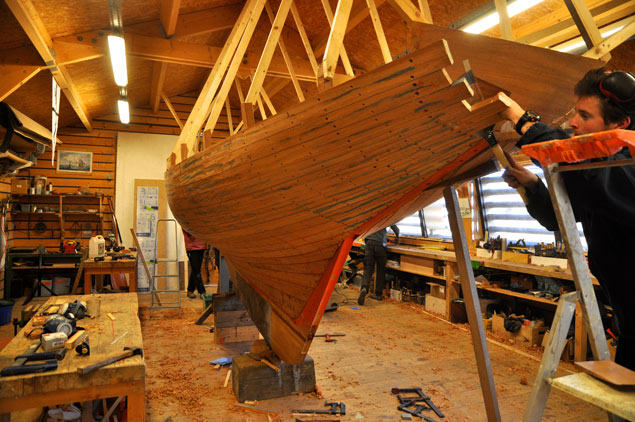 The new Howth Seventeen planked. Skol ar Mor has exceptionally pleasant though unpretentious premises
The new Howth Seventeen planked. Skol ar Mor has exceptionally pleasant though unpretentious premises
Yet in France and other countries, the resources are there, but it is by no means an easy way of life. You need more than just the skills of a boat-builder. The gift of being able to teach must be part of your makeup. And a capacity for empathy with society’s uncertain and sometimes even maladjusted young people will inevitably come up on the agenda.
On top of all that, you – or at least somebody on your team – must have a good head for business. This is no cakewalk. Yet when it is running well, it is such a power for the good in every way that it is always worth persevering.
The value of the work done by Skol ar Mor has been recognized with the presentation to Mike Newmeyer of the French Maritime Academy’s highly-regarded Joshua Slocum Award, an occasion which resulted in the great man appearing in a much more formal outfit than is usually seen by those who work with him in creating classically-crafted boats.
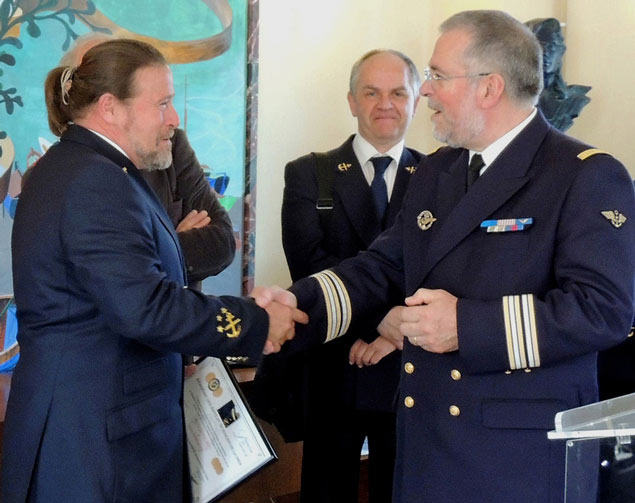 Mike Newmeyer (left) as you’ve never seen him before, being honoured by the French Maritime Academy with the Joshua Slocum Award.
Mike Newmeyer (left) as you’ve never seen him before, being honoured by the French Maritime Academy with the Joshua Slocum Award.
The range of boats his staff and trainees create each academic year from early September until the end of July has to be comprehensive in covering several methods of wood construction, and different types of boats. To achieve this, Skol ar Mor has drawn increasingly on vintage Irish designs, with a Water Wag, a Shannon One Design and the Dublin Bay 24 Periwinkle emerging in new form in recent years.
As the Howth Seventeen of 1898 vintage is just 22ft 6ins in hull length, she is of the ideal size for her construction to fill the length of the programme through two full semesters of September to January, and January to July. And as a keelboat, she presents enough construction challenges to be something of a diploma project in her own right. That’s before you start to deal with the Howth 17 owners, for whom high levels of keenly-expressed individuality provide the default setting.
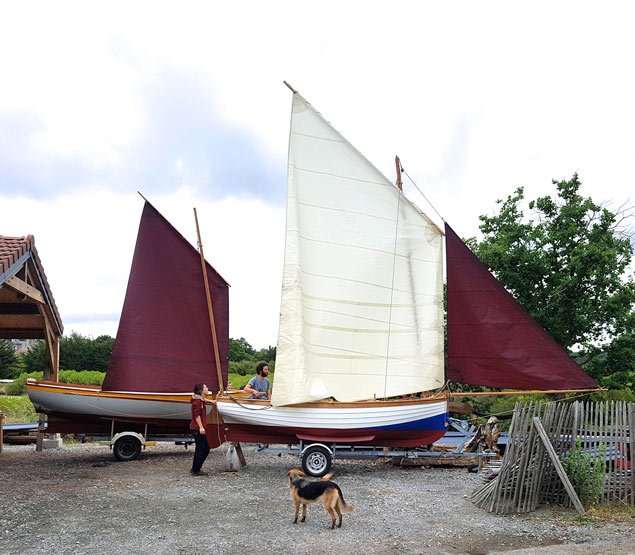 If it’s a boat and it’s in wood, Skol ar Mor will build it. These are some of the new boats which were launched with the new Howth 17 on July 22nd. Photo: Luke Malcolm
If it’s a boat and it’s in wood, Skol ar Mor will build it. These are some of the new boats which were launched with the new Howth 17 on July 22nd. Photo: Luke Malcolm
But when Ian and Judith Malcolm – who already own the 1898 Hilditch of Carrickfergus-built Howth 17 Aura – decided they’d like to try the experience of having a new boat built to the old design by Skol ar Mor, in dealing with Ian Malcolm the team in France – a notably international crew - were interacting with someone whose passion in life has been the preservation and growth of the Howth Seventeen Class, a mission in which he is rivalled only by Nick Massey, who did great work to get the class together in fresh strength for its 75th Season in 1972, and continues to be much involved.
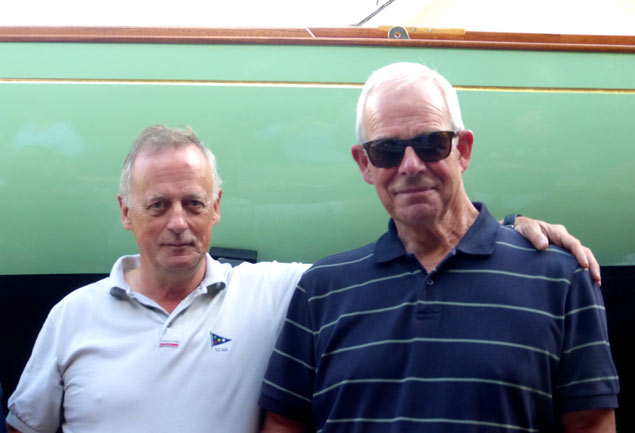 Keepers of the flame. Ian Malcolm (left) and Nick Massey have been the primer movers in the invigoration of the Howth 17 class for the last 35 years. Photo: W M Nixon
Keepers of the flame. Ian Malcolm (left) and Nick Massey have been the primer movers in the invigoration of the Howth 17 class for the last 35 years. Photo: W M Nixon
It tells us something about the class that they insisted on celebrating in 1972, which was indeed their 75th Season, but their 75th Anniversary didn’t occur until the following year. However, the Centenary Year of 1998 was clearcut and celebrated with vigour, and now with the class at 119 years old, it was time to try something new, a foreign build with the design being used as a boat-building training exercise by an internationally-recognised institution.
The deal for Ian Malcolm was he would pay for all materials used including a multiplicity of timber, fastenings, paint, varnish and so forth, but the actual work of boat-building – the labour and skills – would be provided “free” through Skol ar Mor under the national and regional boat-building training schemes.
Building a Howth Seventeen appropriate to the circumstances of 2017 did not mean a rigid adherence to the timbers as originally specified when the design by Walter Herbert Boyd of Howth House was signed off on October 22nd 1897. One hundred and twenty years ago, top quality pines, firs, oak and other useful boatbuilding woods were still available in quality profusion. But many of today’s available pines are regarded as “unstable”, and classic boat-builders have to search out formerly obscure timber that will best fulfil the original designated roles.
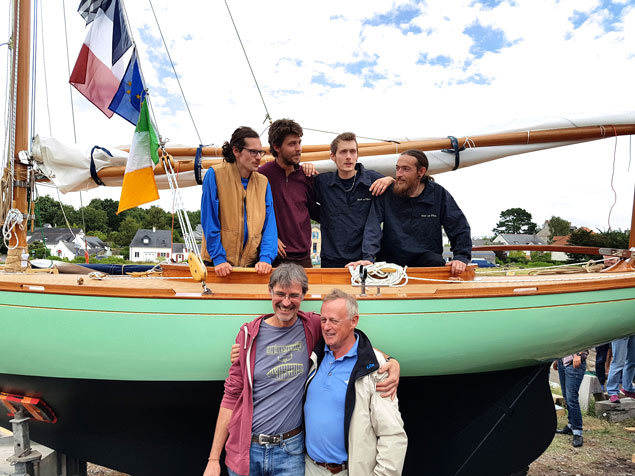 The build team with shipwright-instructor Jacques Audoin and Ian Malcolm in foreground. The unique shade of green is Jacques’ personal preference. Photo: Luke Malcolm
The build team with shipwright-instructor Jacques Audoin and Ian Malcolm in foreground. The unique shade of green is Jacques’ personal preference. Photo: Luke Malcolm
Thanks to the encyclopaedic timber knowledge of Mike Newmeyer and his colleagues, the new Howth Seventeen has appeared with her construction including woods virtually unknown at the time when her design was still newly-minted. Thus although the basic keel is oak, the stem is laminated sapele, and sapele is also used in the sweetly-shaped little transom. The ribs (or more properly timbers) are steamed oak, but the frames are laminated oak, yet the hull planking is khaya, an obscure wood, with the qualities of good mahogany, found in east Africa and Madagascar. The decks are laid pine on a marine ply base on yellow pine frames, and the spars are Oregon pine.
While the building may have been taking place in a relatively distant place on France’s Atlantic Coast, the thoughts of many were with the project, for the Howth Seventeens have some special links with France. The great Eric Tabarly’s pet boat Pen Duick, which had been brought into the Tabarly family by his father, was a Fife-designed 43ft cutter built in Cork Harbour in 1898, the same year as the Seventeens, and when two of the Howth Seventeens took part in the Brest Festival in 1992, they found themselves in company with Pen Duick.
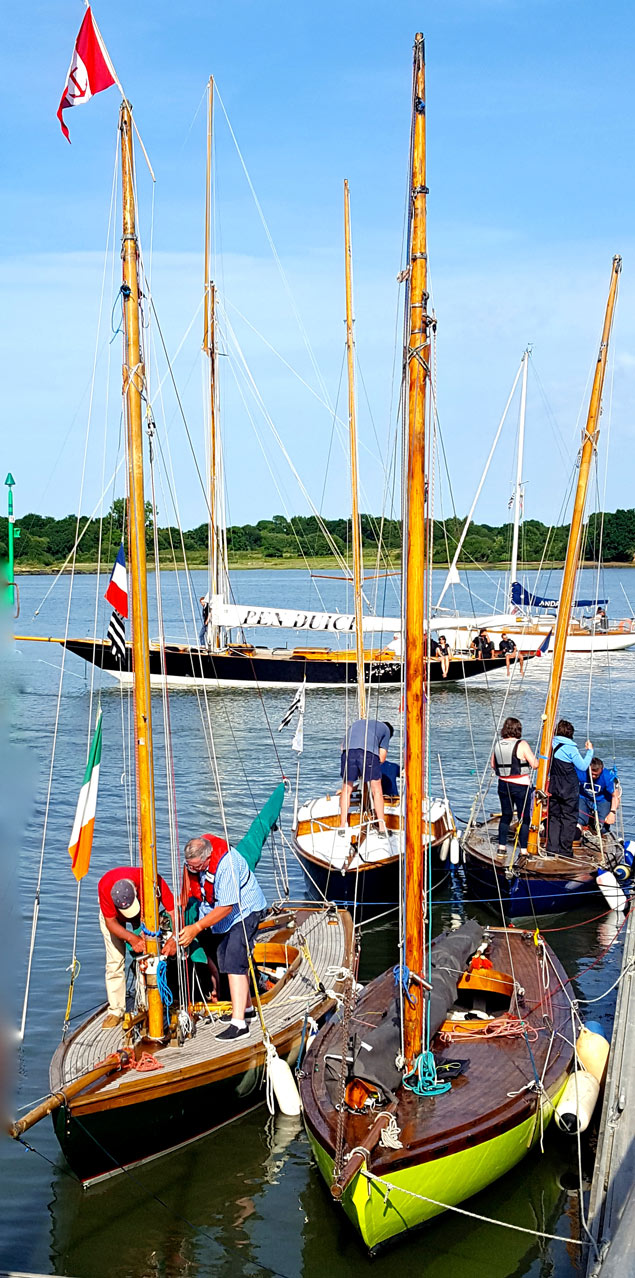 Fortuitous meeting. The famous Pen Duick with the Howth Seventeens in the Morbihan in late May. Photo: Cillian Macken
Fortuitous meeting. The famous Pen Duick with the Howth Seventeens in the Morbihan in late May. Photo: Cillian Macken
Their presence registered with the great man, and when in 1998 he was lost overboard off the Welsh coast while sailing Pen Duick to the Fife Regatta on the Clyde, his body was eventually brought in by a Dunmore East trawler, and was subsequently identified and claimed in Dublin by his brother Patrick. While making this brief but sad visit to Dublin, Patrick Tabarly had one special request. He asked to be taken to Howth and allowed to sit aboard a Howth Seventeen with some time to himself to honour the memory of his brother. It was something which was done with so little fuss and so much respect at the time that it had almost been completely forgotten, until the arrival of the new French-built Seventeen into Howth Yacht Club last weekend stirred some poignant memories.
So it had only been pure serendipity that when six Howth Seventeens went with a dozen Water Wags to the great gathering of boats in late May in the Morbihan, they found themselves sharing the sea in mutual admiration with Pen Duick.
Meanwhile, at Mesquer nearby, the new Howth Seventeen was nearing completion. But her time would come two months later, when term ended at Skol ar Mor and all the boats created during the winter’s programme were revealed to an adoring crowd, with the new Howth Seventeen in a starring role.
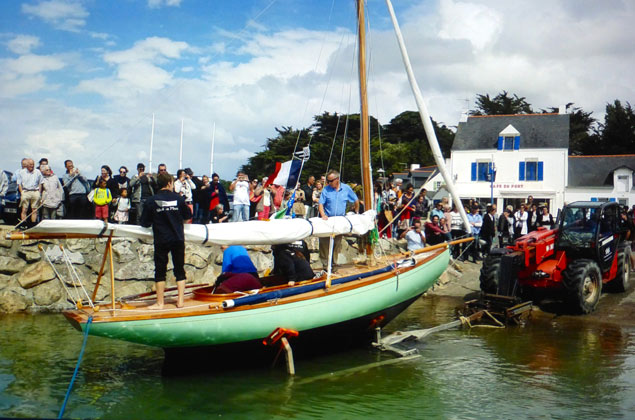 First launching for new boat at Skol ar Mor Open Day, Saturday July 22nd. Despite the nearby distractions of Café du Port, the Irish team and their boat were headed for home early next morning. Photo: Luke Malcolm
First launching for new boat at Skol ar Mor Open Day, Saturday July 22nd. Despite the nearby distractions of Café du Port, the Irish team and their boat were headed for home early next morning. Photo: Luke Malcolm
It was an extraordinary event on Saturday July 22nd. The whole neighbourhood was en fete and everything, including the launching of the Seventeen, was accompanied by enthusiastic applause. She is of an unusual shade of pale green, but that was no surprise to the locals. It’s the preferred colour of Skol ar Mor’s lead shipwright Jacques Audoin, and he sees to it that his favourite creations are finished in it if at all possible, so having that colour is a badge of honour.
 The first sail of all, on the Morbihan with the build crew, Saturday July 22nd. Early next morning, the boat was on the road to the ferry at Cherbourg. Photo: Luke Malcolm. It was one hectic weekend for Ian Malcolm and his son Luke, a qualified yachtmaster briefly home from a superyacht in the Pacific to do the Fastnet, as they’d to get back with the boat to Ireland via the ferry from Cherbourg through the remainder of the weekend. It took steely determination in the midst of all the celebrations to unrig the Seventeen and lift her into the road trailer to hit the road early on Sunday morning for eventual arrival back to Howth at noon on Monday.
The first sail of all, on the Morbihan with the build crew, Saturday July 22nd. Early next morning, the boat was on the road to the ferry at Cherbourg. Photo: Luke Malcolm. It was one hectic weekend for Ian Malcolm and his son Luke, a qualified yachtmaster briefly home from a superyacht in the Pacific to do the Fastnet, as they’d to get back with the boat to Ireland via the ferry from Cherbourg through the remainder of the weekend. It took steely determination in the midst of all the celebrations to unrig the Seventeen and lift her into the road trailer to hit the road early on Sunday morning for eventual arrival back to Howth at noon on Monday.
By this stage the whole thing was taking on something of the atmosphere of the sacred relics of a saint being taken on tour. Summer had arrived on the Howth peninsula, rare enough in 2017, and on that same perfect evening, Judith organised a garden party for the Howth 17 Class elders and others of goodwill to see the new boat for the first time. When they actually saw the exquisite result of eleven months of loving work in Skol ar Mor, the mood was of pure reverence until a certain conviviality inevitably broke through.
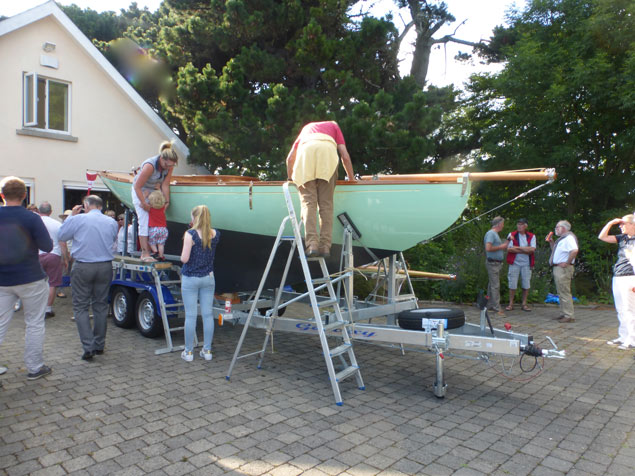 Home at last. The new boat on her first day on the Howth peninsula. Photo: W M Nixn
Home at last. The new boat on her first day on the Howth peninsula. Photo: W M Nixn
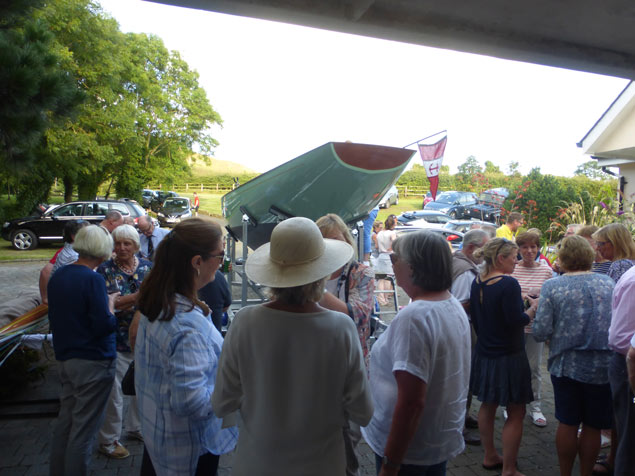 A perfect excuse for a garage/garden party – a new boat just home, and summer arrives. Photo: W M Nixon
A perfect excuse for a garage/garden party – a new boat just home, and summer arrives. Photo: W M Nixon
 Maybe two hundred years of Howth Seventeen skippering experience with (left to right) Nick Massey, Paddy Cronin, Davy Jones, Tom Houlihan, Roddy Cooper and Ian Malcolm. Photo: W M Nixon
Maybe two hundred years of Howth Seventeen skippering experience with (left to right) Nick Massey, Paddy Cronin, Davy Jones, Tom Houlihan, Roddy Cooper and Ian Malcolm. Photo: W M Nixon
Then last Saturday, July 29th, the new boat – now named Orla in fond memory of Ian Malcolm’s late sister – came centre stage for her official debut and launching at Howth Yacht Club. But that couldn’t happen until late afternoon in order to allow the Howth 17s to race, for nothing is allowed to interrupt the Howth Seventeen’s regular Saturday race, and most appropriately it was won by John Curley and Marcus Lynch in Rita, the very first Howth 17 to have arrived new in Howth from Carrickfergus, way back in April 1898.
The classic boat community was well represented as the launching ceremony approached, and HYC Commodore Joe McPeake found himself presiding over an event in which the attendance included a goodly contingent from the Water Wags in Dun Laoghaire, some of whom had strong connection with the Howth class from the time when the southside division was known as the Dublin Bay 17s, though those boats have long since been brought into the Howth fold.
 This is the Howth of today – the new Howth Seventeen just arrived at the HYC Clubhouse/Marina complex, and Dave Cullen’s classic Half Tonner Checkmate packed up and ready to hit the campaign trail. Photo: W M Nixon
This is the Howth of today – the new Howth Seventeen just arrived at the HYC Clubhouse/Marina complex, and Dave Cullen’s classic Half Tonner Checkmate packed up and ready to hit the campaign trail. Photo: W M Nixon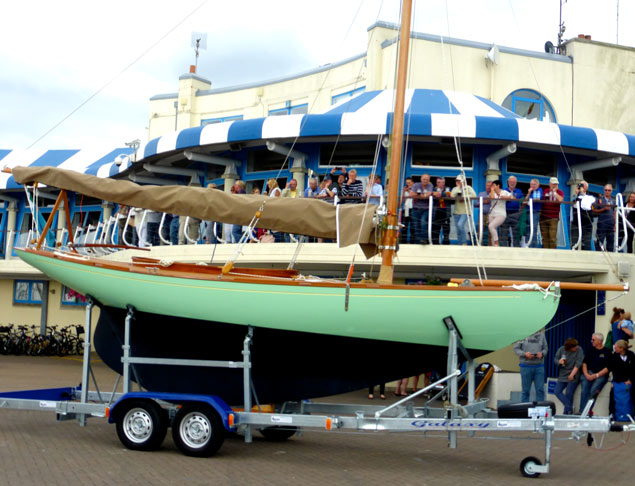 On parade – the new boat with the crowd starting to gather on the balcony for the naming ceremony. Photo: W M Nixon
On parade – the new boat with the crowd starting to gather on the balcony for the naming ceremony. Photo: W M Nixon
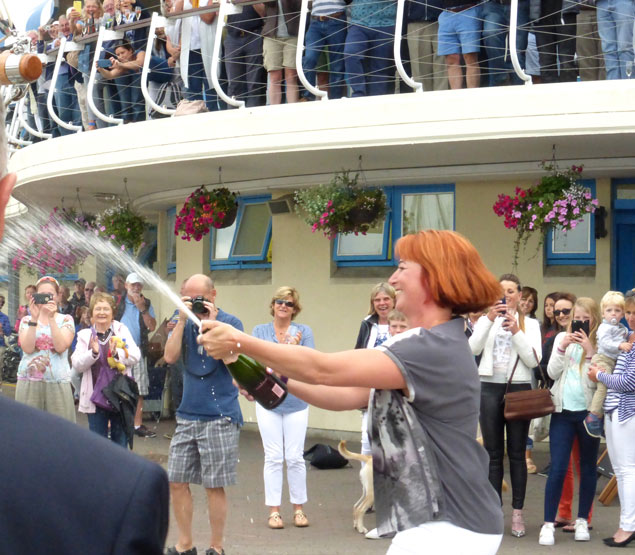 Noted sailor Steph Ennis does the honours, naming the new boat for her late mother Orla Malcolm Ennis. Photo: W M Nixon
Noted sailor Steph Ennis does the honours, naming the new boat for her late mother Orla Malcolm Ennis. Photo: W M Nixon
In fact, it was very much a down home affair, with several other harbour and village groups out in strength, but it was thanks to Mick Foy of Tullamore’s St Colmcille Pipe band that it all became very special indeed. Mick had been in Howth to be the lone piper at the annual Asgard Day Parade that morning down the East Pier, and a sailing genius who prefers to remain anonymous suggested to him that if he wished, there were further opportunities for some musical accompaniment that afternoon across at the yacht club.
So the new Howth 17 was serenaded with some really classy piping, than after the late Orla Malcolm Ennis’s daughter Steph Ennis had named and anointed the new boat Orla, Mick the Piper led the way to the crane and a very smooth launching ceremony, for which he so skillfully shaped his music to get the right mood as the keel kissed the waters of Howth Harbour for the first time that you’d swear they do ceremonial boat launchings into the Grand Canal in Tullamore every day.
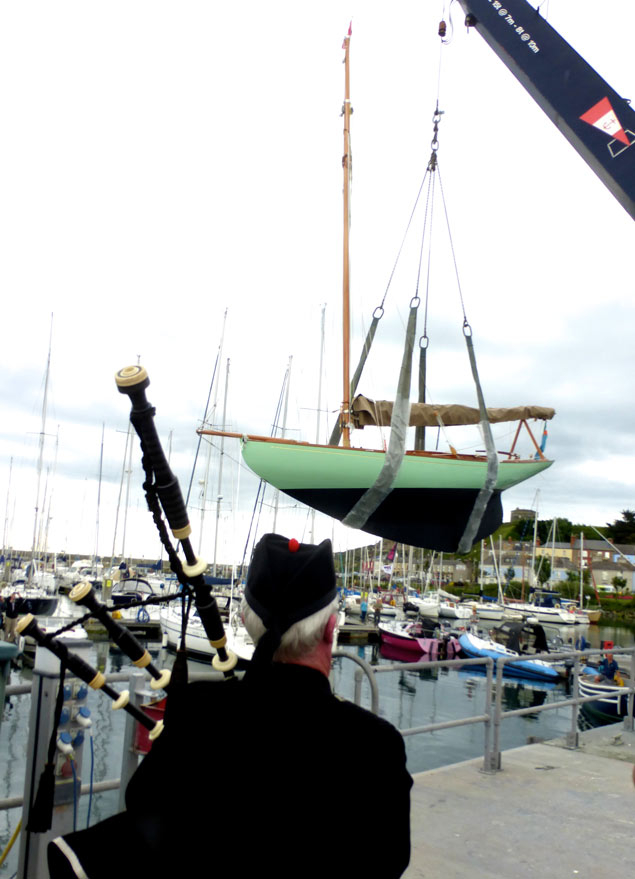 Piper Mick Foy from Tullamore provided the perfect accompaniment for a very special launching event. Photo: W M Nixon
Piper Mick Foy from Tullamore provided the perfect accompaniment for a very special launching event. Photo: W M Nixon
Since then, it has been onwards and upwards for the new Orla. Ian and Judith had their first sail on Sunday morning, then they were joined by fellow classic boat fans Con Murphy and Cathy MacAleavey to share the experience, and then Tuesday August 1st was the big one, the first outing with the class on their regular Tuesday evening race.
A dozen boats were out, and as they’ve only three races left in the current midweek series, it was agreed that Orla could pace with them rather than race properly, as actually racing would involve having to stump up the total series entrance fee, an unconscionable expense to Howth minds, with only three races to go.
The message from all this is that doing well in boat races seems to be a matter of keeping well clear of other boats, and simply keep pacing with them. Orla seems to be pretty much the same speed as the older Howth Seventeens, but because Ian Malcolm kept clear and allowed the rest to get into the usual tussles with each other, they approached the finish line on a reach with Orla in the lead, just three boat lengths ahead of the Massey syndicate’s Deilginis.
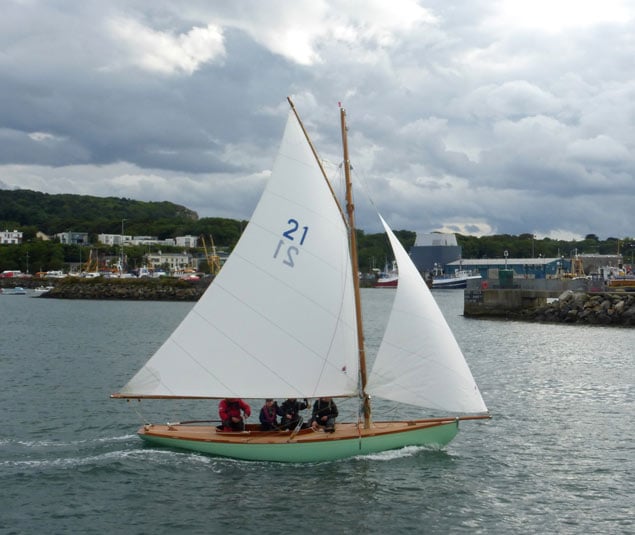 Heading out for the first race and looking thoroughly at home in Howth already. The Howth Seventeens don’t carry their famous jackyard topsails for midweek evening races. Photo: W M Nixon
Heading out for the first race and looking thoroughly at home in Howth already. The Howth Seventeens don’t carry their famous jackyard topsails for midweek evening races. Photo: W M Nixon
That’s the way it was at the line, and it couldn’t have been more appropriate in the context of the history of the class. For it was through Nick Massey’s inspiration in 2013 that the Howth Seventeens broke free of out-dated timber specifications thanks to his organization of Deilginis’s journey to Rui Ferreira in West Cork for the fitting of the class’s first teak deck. It looked wonderful, and put the enduring little boats of Howth onto a new story line that has now completed another chapter with the successful debut of Orla.
However, her honeymoon period will soon be over. From August 11th to 13th, the Howth Seventeens will be staging their annual championship. It will be open season for all boats, old and new alike.
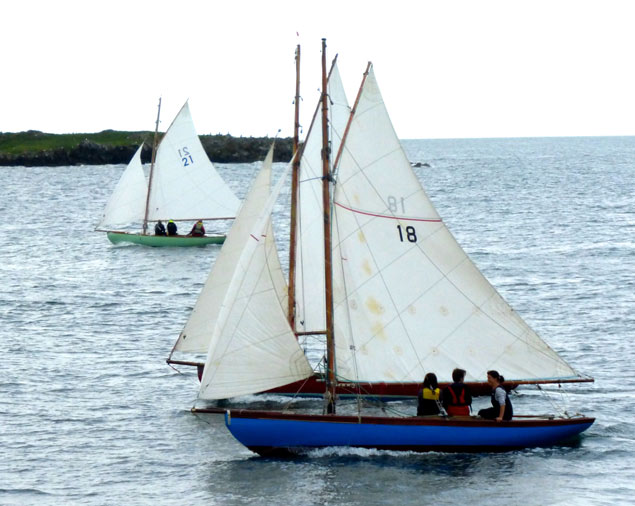 As an unofficial participant in the race on Tuesday evening, new boat Orla No 21 tried to keep well clear of the other boats. This resulted in her winning. Photo: W M Nixon
As an unofficial participant in the race on Tuesday evening, new boat Orla No 21 tried to keep well clear of the other boats. This resulted in her winning. Photo: W M Nixon


























































